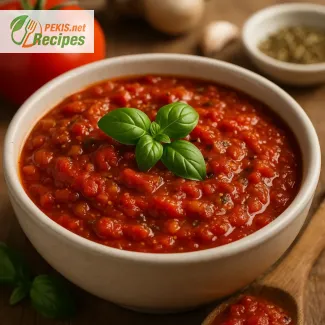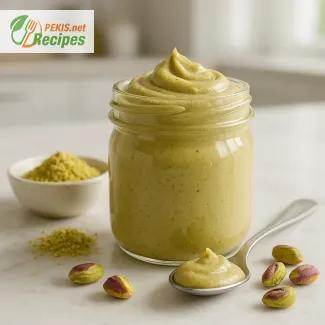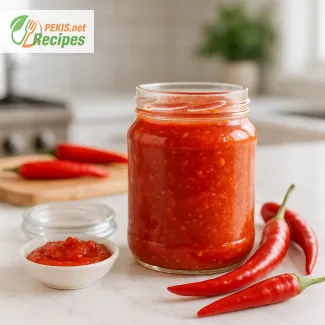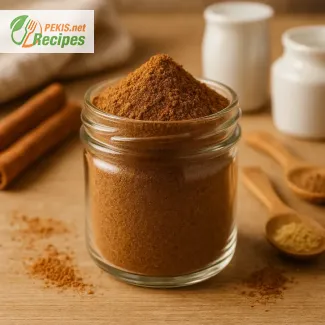4 servings, 15 minutes prep, 45 minutes cook, total 60 minutes. Homemade tomato sauce delivers a rich balance of ripe tomatoes, garlic, onion, olive oil, and fresh basil, creating a smooth yet hearty base for pasta, pizza, and stews. The slow simmer unlocks natural sweetness and depth, while optional red pepper flakes add a gentle kick. Stored in the fridge for 5 days or frozen for 2 months, it reheats easily and keeps its fresh, comforting flavor ready for quick meals.
PEKIS – professional chef and recipe developer with more than 25 years of experience, specializing in European and international cuisine. For this tomato sauce, I’ve worked with fresh garden produce and traditional Italian techniques, making sure the flavors of ripe tomatoes, garlic, and basil come through in every spoonful.

Rich and Flavorful Tomato Sauce Made from Scratch
The timeless base for pasta, pizza, and slow-cooked dishes
A pot of homemade tomato sauce carries with it more than just flavor – it represents comfort, tradition, and the artistry of transforming simple ingredients into something deeply satisfying. Whether spooned generously over al dente pasta, spread as a luscious base on a crisp pizza crust, or simmered into a hearty stew, this sauce provides the backbone for countless meals. Its versatility makes it a staple in kitchens around the world, celebrated for its ability to enhance and elevate nearly any savory dish.
The soul of the sauce lies in the tomatoes, chosen at their ripest to deliver sweetness, acidity, and depth. When simmered slowly, the fruit develops a velvety texture and an intensified taste that clings beautifully to pasta or soaks into fresh bread. The addition of aromatics like onions, garlic, and herbs infuses the sauce with warmth and character, while a drizzle of olive oil ties everything together, creating a smooth, silky consistency. A pinch of salt and freshly ground pepper sharpen the flavors, while optional spices such as red pepper flakes add a gentle kick for those who prefer heat.
Origins and culinary heritage
The tradition of simmering tomato sauce dates back to southern Italy, where it became a cornerstone of Mediterranean cuisine after the introduction of tomatoes from the New World in the 16th century. Over centuries, families developed their own variations, some enriched with wine, others with butter or stock, each reflecting regional identity. In Italian-American households, big batches of sauce became synonymous with Sunday gatherings, filling homes with aromas that promised abundance and togetherness. Today, this heritage endures, with the sauce serving as a universal foundation for both rustic meals and refined creations.
Why you will love this recipe
- Rich depth of flavor from slow-cooked ripe tomatoes
- Versatility: works for pasta, pizza, casseroles, or as a base for braised meats
- Customizable with fresh herbs, spices, or even a splash of wine
- Comforting and familiar, yet endlessly adaptable
- Easy to batch cook and freeze for future meals
Key culinary elements and ingredient synergy
- Tomatoes provide sweetness, acidity, and umami richness.
- Garlic and onions build the savory backbone and aromatic lift.
- Herbs such as basil, oregano, and thyme contribute earthy freshness.
- Olive oil ensures smoothness and richness in every bite.
- Seasoning balance with salt, pepper, and optional chili flakes sharpens complexity.
This interplay of elements creates a sauce that is simultaneously bright and robust, fresh yet comforting. It is adaptable to personal preference, allowing the cook to experiment with roasted vegetables, grilled peppers, or even mushrooms for added depth.
Creative variations to try
- Rustic style: Keep the sauce chunky with hand-crushed tomatoes for a farmhouse texture.
- Velvety smooth: Puree the sauce with an immersion blender for a restaurant-like finish.
- Wine-infused: Add a splash of red or white wine for complexity and subtle sweetness.
- Spicy version: Elevate with chili flakes, cayenne, or a touch of smoked paprika.
- Herb-forward: Finish with fresh basil leaves or parsley right before serving for a bright, aromatic finish.
Storage and make-ahead tips
Homemade tomato sauce is not only delicious but also convenient to store for busy days.
- At room temperature: up to 2 days in a sealed container.
- Refrigerated: up to 5 days in a glass jar or airtight container.
- Frozen: up to 2 months without losing quality.
- Reheating: warm gently in a saucepan or oven at 150 °C for 8–10 minutes until hot and aromatic.
Practical uses and pairings
- Toss with freshly cooked spaghetti or penne for a quick, satisfying meal.
- Spread on pizza dough as a flavorful foundation for cheese and toppings.
- Layer into baked lasagna or cannelloni for comforting, oven-baked perfection.
- Spoon over grilled chicken, meatballs, or roasted vegetables to enrich their flavor.
- Serve as a dipping sauce for garlic bread, mozzarella sticks, or oven-baked snacks.
Beside being an essential Mediterranean classic, this sauce is a blank canvas for creativity in the kitchen. It encourages experimentation, adapts to any season, and carries a culinary history that makes every bite meaningful. A jar of homemade tomato sauce in your fridge or freezer guarantees that a comforting, flavorful meal is always just minutes away.
- Heat olive oil in a large saucepan over medium heat.
- Add chopped onion, garlic, carrot, and celery. Sauté for 6–8 minutes until softened and aromatic.
- Stir in tomato paste and cook for 2 minutes to deepen its flavor.
- Add chopped ripe tomatoes, sugar, oregano, salt, and pepper. Mix well.
- Pour in water or vegetable stock and bring to a gentle simmer.
- Reduce the heat to low, cover partially, and let it simmer for 35–40 minutes, stirring occasionally.
- Add fresh basil leaves and optional red pepper flakes.
- For a chunky texture, leave the sauce as it is. For a smooth sauce, blend with an immersion blender until silky.
- Taste and adjust seasoning before serving.
FAQ questionCan I use canned tomatoes instead of fresh?
Absolutely. High-quality whole canned tomatoes (ideally San Marzano) give reliable sweetness and low acidity year-round. If using canned, drain excess liquid if you want a thicker sauce and crush by hand for a rustic texture. With fresh tomatoes, peel and deseed for a smoother finish; peak-season fruit delivers brighter flavor but can vary in acidity—balance with a pinch of sugar or grated carrot.
FAQ questionHow do I reduce acidity or bitterness?
Slow simmering mellows sharp edges. Build sweetness naturally by sweating onion and garlic in olive oil until translucent, then toast the tomato paste for depth. If it still tastes sharp, add a small pinch of sugar or a knob of butter to round it out. A micro-pinch of baking soda can neutralize acidity—use sparingly to avoid a flat or soapy taste.
FAQ questionWhat’s the best way to thicken without flour?
Use evaporation: simmer uncovered to reduce by 10–25% until the spoon leaves a light trail. Purée part (or all) of the sauce with an immersion blender for body. A little tomato paste intensifies color and viscosity. For a silky cling on pasta, finish with a splash of starchy pasta water while tossing.
FAQ questionWhich herbs and spices work best—and when do I add them?
Add dried oregano and thyme early so they hydrate and infuse. Stir fresh basil in at the end to preserve its bright aroma. A bay leaf during simmering adds gentle complexity; red pepper flakes deliver heat—start small and adjust. Finish with freshly cracked black pepper and good extra-virgin olive oil for a clean, glossy finish.
FAQ questionHow can I make the texture smooth or keep it chunky?
For smooth sauce, pass it through a food mill or blend until velvety; strain if you want it ultra-fine (great for pizza). For chunky sauce, hand-crush tomatoes and avoid aggressive stirring. You can blend just half the pot and fold it back in for a balanced, spoon-coating texture.
FAQ questionWhat are smart make-ahead and storage tips?
Cool quickly and portion into jars or freezer-safe containers, leaving headspace. Refrigerate up to 5 days; freeze up to 2 months. Reheat gently on the stovetop or in the oven at 150 °C for 8–10 minutes until piping hot. Freeze extra in ice-cube trays for quick weeknight portions or to enrich stews and braises.
FAQ questionHow do I use this sauce beyond pasta?
Spread a thin layer on pizza for a bright, non-watery base. Spoon under meatballs, over roasted vegetables, or use as a braising medium for chicken or beans. It’s a vibrant base for shakshuka, a quick lasagna layer, or a dip for garlic bread. Adjust thickness with a splash of water for simmering dishes or reduce further for baking applications.
A simmering pot of tomato sauce has the power to transform everyday meals into something memorable. Its balance of ripe tomatoes, aromatic garlic, onions, and fragrant basil creates a foundation that works as well on a simple bowl of pasta as it does layered into baked dishes or spread over crisp pizza dough. The sauce’s adaptability means it fits into weeknight cooking just as naturally as into slow weekend meals shared with friends and family.
The depth of flavor comes not only from the ingredients but also from the method. Allowing the sauce to cook slowly gives the tomatoes time to release their natural sweetness while the aromatics infuse with warmth. A splash of olive oil ties everything together, making the texture smooth and glossy, while herbs like oregano and basil keep the character fresh and vibrant.
Cooking a batch ensures more than one meal is covered. Stored properly, it can last several days in the fridge or months in the freezer, keeping its rich flavor intact. This makes homemade tomato sauce both a practical and comforting choice—ready to elevate a quick weekday dinner or add depth to a carefully prepared family recipe.
Every spoonful tells a story of tradition, simplicity, and the beauty of combining fresh ingredients into something timeless. From the Mediterranean roots of Italian kitchens to modern tables worldwide, this sauce continues to connect people through flavor, warmth, and the joy of shared food.
Allergens present in the recipe
- None naturally occurring in the base recipe.
Gluten information
- The sauce itself is gluten-free.
- Risk of gluten presence only if thickened with flour or served with gluten-containing pasta.
Tips for allergen and gluten substitution
- Serve with gluten-free pasta, pizza base, or bread to keep the entire meal gluten-free.
- Replace celery with zucchini or fennel if celery allergy is present.
- For onion intolerance, substitute with leek greens or omit completely.
- Vitamin C: 35 mg – supports immune system and skin health
- Vitamin A: 950 IU – promotes vision and cellular health
- Vitamin K: 12 mcg – important for blood clotting and bone health
- Potassium: 820 mg – regulates fluid balance and supports heart health
- Magnesium: 38 mg – contributes to muscle and nerve function
- Iron: 2.2 mg – essential for oxygen transport in the blood
- Calcium: 55 mg – supports bones and teeth
- Lycopene: 12 mg – powerful antioxidant linked to heart health and cancer prevention
- Beta-carotene: 1.8 mg – supports eye health and reduces oxidative stress
- Polyphenols: 110 mg – anti-inflammatory and protective for cardiovascular health





